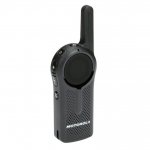The plan to switch for Sam's Club and Walmart to a similar system was also announced several months ago. The only way to monitor is by having a radio set up with the same parameters as the radios in the store. Your chances of guessing that setup are less than winning the lottery.
I believe Walmart* from what I read is moving to a particular Samsung smartphone and uses their in-store WiFi. This is unrelated to the 900MHz DLRs.
As jaspence said, the only inexpensive and practical way to monitor them is to have one yourself, AND it has to be set to the same frequency hopset and talkgroup ID. Your chances of guessing the Target setup are actually much better than winning the lottery. The Motorola 900MHz DLR and DTRs will talk to each other right out of the box at the factory default settings. No programming is required to get these radios talking to each other right out of the box. I have found people tend to use these radios right out of the box at the factory default settings like FRS bubble packs. You very likely may hear them on the default public talkgroups. If Target is using the 4-digit Profile ID Number (PIN) feature and set the PIN to something other than the 0000 default, then you are SOL and won't hear anything. My guess is they are using them like FRS bubble packs.
The local Costco Wholesale store near me uses DLRs at the factory defaults and I can hear them on my DTR650 and DTR700 radios when I'm in range. I purposely keep the default public talkgroups in my DTR programming so I can monitor for activity in my travels and to be able to talk to DTRs and DLRs outside my group if needed. I also have a few private talkgroups in my DTR programming so I can stay private when I want to. While technically not encrypted, the DTRs and DLRs can be made very secure.
I have achieved several miles of range with my DTRs and also with DLRs but I never got them to set any range records. My range record stands at 12 miles along the Florida Space Coast. My fleet of DTRs are my professional quality digital replacement for GMRS/FRS for local on-site simplex type use with family and friends. A coworker once asked me why not just use FRS? My answer was that I have already been doing that since FRS was created in 1996 and longer than that as a GMRS licensee since 1992 and using top quality commercial gear. I want a 100% digital end to end solution that is higher quality and more professional than FRS. The DTRs and DLRs totally blow FRS away in range and performance and in some cases beats conventional UHF portables on simplex. They work amazingly well yet people keep underestimating them because of their 1W transmit power and 900MHz operation. Not having to worry about FCC licensing and being completely scanner proof come as bonuses.
The DLRs make perfect sense for retail type use and as a digital replacement for the CLS series. They make sense for the target market. DLR = Digital Lightweight Radio, according to Motorola.





